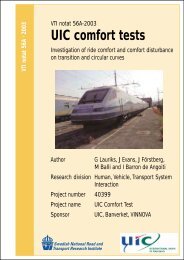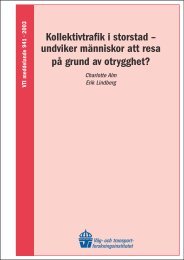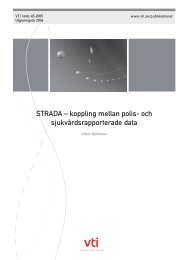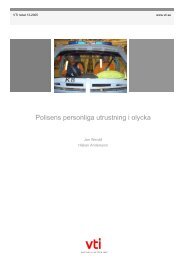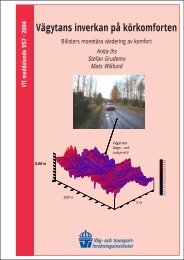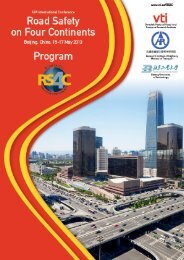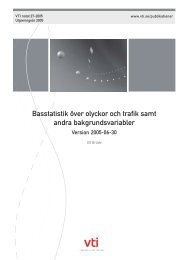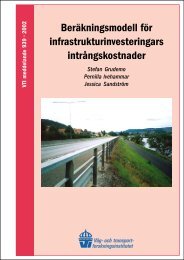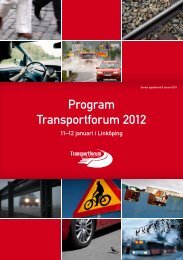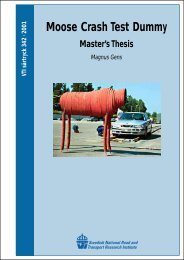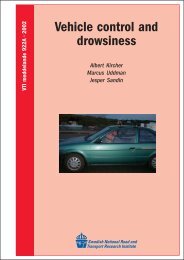Missing text /vti/pages/publication/downloadpdf for sv
Missing text /vti/pages/publication/downloadpdf for sv
Missing text /vti/pages/publication/downloadpdf for sv
You also want an ePaper? Increase the reach of your titles
YUMPU automatically turns print PDFs into web optimized ePapers that Google loves.
integrated with pedestrian and cycle traffic, and can be routed along pedestrian<br />
streets and other city centre areas where car traffic is prohibited or is subject to<br />
strict limitations. The streetspace can be utilised most effectively with light rail,<br />
followed by bus, cycle and car. Car traffic places almost twenty times as great a<br />
demand on the streetspace as light rail traffic. The area of land required by buses<br />
is almost twice that required by light rail. In many cities, light rail has also<br />
become a symbol of a modern and attractive city.<br />
The other function of light rail is to provide radial transport towards the city<br />
centre. The longer the routes and the larger the catchment area, the greater the<br />
capacity which the systems have, ranging from trams and streetcars, through light<br />
rail and metro, to heavy rail in the <strong>for</strong>m of suburban and commuter trains. The<br />
boundaries and definitions between different types of railbound transport systems<br />
are indistinct. Development of modern dual purpose systems, TramTrains, means<br />
that the function as city centre shuttle system and transport provider in local and<br />
regional corridors can be integrated in one and the same transport system.<br />
It must however be said that no system based on light rail and/or bus has been<br />
successful merely on its own merits. That public transport as such must satisfy<br />
stringent demands <strong>for</strong> ”system internal” effectiveness and that the systems must<br />
be provided with adequate resources, can be seen as a self-evident prerequisite.<br />
Factors such as routing, integration, service frequency, com<strong>for</strong>t, safety and speed<br />
must work satisfactorily. This means, in turn, that there must be an organisational<br />
and institutional structure which is able to produce these results. But what is<br />
mainly shown by an examination of the state of knowledge is that these system<br />
internal qualities must also be backed up by ”system external” conditions.<br />
Examples of these are physical planning regarding the way land is to be built on<br />
and utilised in the short and long term, general traffic planning regarding the way<br />
the transport system is to be designed, and a large number of direct measures<br />
which influence the way in which passenger traffic is carried by other modes. It<br />
has been shown with all desired clarity that it is essential to strengthen the<br />
competitiveness of public transport, primarily in relation to the car, in order that a<br />
successful overall solution may be achieved. It has been found in many countries<br />
that it is easier, both in terms of public opinion and politics, to carry through such<br />
a reorientation if light rail in cities is part of the future oriented investments.<br />
The research project ”Light Rail – Light Cost, Part II” has functioned as a<br />
unifying plat<strong>for</strong>m <strong>for</strong> the generation of knowledge about the modern light rail<br />
system. In the same way, the actual future prevalence of light rail in Swedish<br />
cities and regions will be dependent on whether it will be possible to achieve<br />
some kind of more unified and advanced strategy and structure <strong>for</strong> the future role<br />
of public transport in Sweden. If the transport and environmental policy goals and<br />
the statements contained in official documents are interpreted literally, it appears<br />
inevitable that the market position of public transport must be improved,<br />
especially <strong>for</strong> local and regional transport.<br />
It is of great importance that research concerning public transport should<br />
continue to focus on those areas in which it has been traditionally active. In the<br />
interim reports produced within this theme, the need <strong>for</strong> knowledge in a number<br />
of distinct subject areas is identified. But it is also important that these<br />
perspectives should be complemented with more research and generation of<br />
knowledge regarding the way public transport systems can be implemented,<br />
organised and operated. The final discussion in the report and the discussion of<br />
the orientation of future research concentrate on these issues.<br />
10 VTI rapport 504



